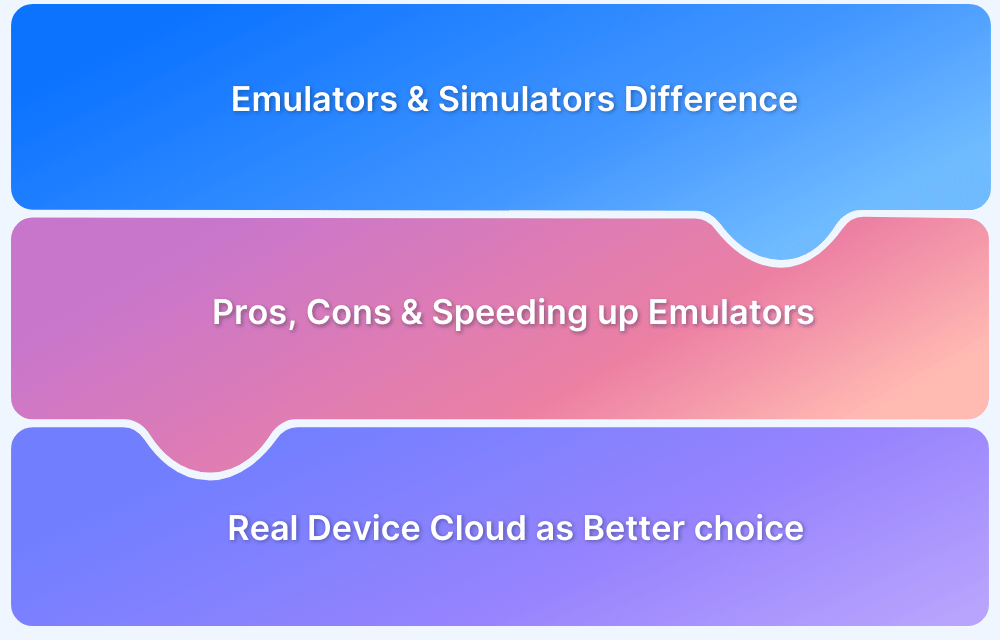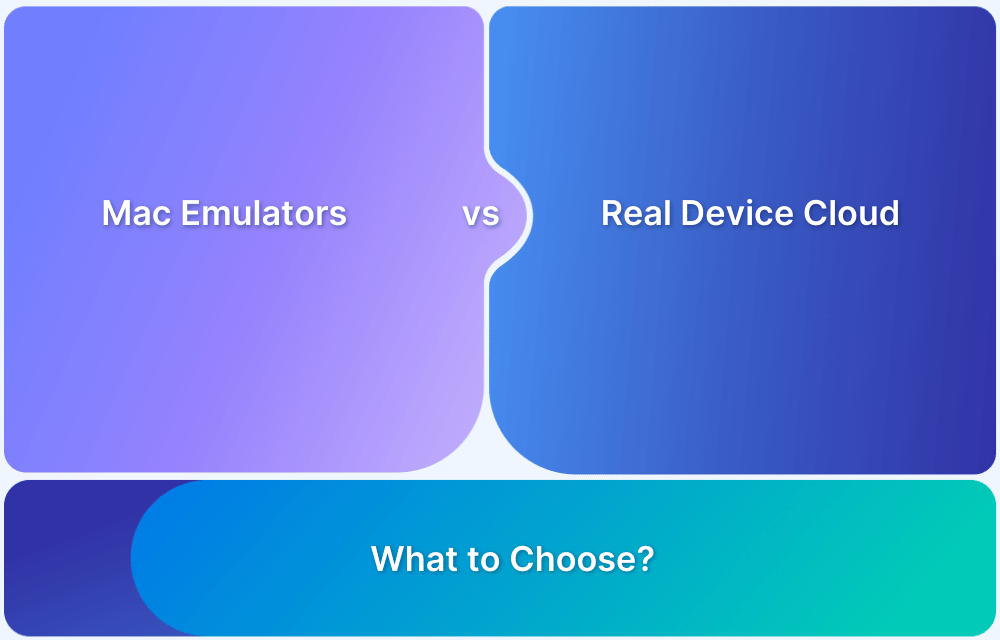Choosing the right testing environment is critical to delivering high-quality Android apps.
Overview
What are cloud Android emulators?
Cloud Android emulators are virtual Android devices accessed via a browser, used for app testing without physical hardware.
Why real devices are better than cloud Android emulators:
- Provide accurate, real-world performance data
- Support full hardware and sensor interactions
- Allow testing under real network and battery conditions
- Offer broader device and OS version coverage
- Eliminate emulator-specific compatibility issues
This article explains how real devices outperform cloud Android emulators for testing and why they’re essential for production-ready app validation.
What is a Cloud Android Emulator?
Regular Android emulators require you to download a virtual machine (VM) and install an Android version before using it. Cloud Android emulators enable access to a virtual machine (the device you need to emulate) hosted entirely on the cloud, so you don’t have to install anything. It runs in a web browser and is remotely accessible to users. All you need is an active internet connection and a browser.
- In this case, you just download the emulator, create an account and access a virtual machine “streamed” to your workstation.
- You don’t have to download the VM – It won’t be stored on your device but rather on the servers of the emulator provider.
- The advantages are obvious: less to download, less to store.
- As long as you have a strong internet connection, using a cloud emulator should be a low-hassle exercise.
Advantages of Cloud Android Emulators
Cloud Android emulators offer a convenient, scalable way to test Android apps without installing heavy software locally. Here are the key benefits:
- Instant Access: Launch virtual devices directly from the browser without setup delays.
- No Local Resource Drain: Offloads processing to the cloud, reducing strain on local machines.
- Cross-Platform Compatibility: Works across Windows, macOS, and Linux with no OS restrictions.
- Scalable Testing: Easily run multiple sessions or test in parallel as needed.
- No Installation or Maintenance: Avoid the complexity of downloads, updates, and emulator configurations.
- Ideal for Quick Debugging: Great for fast UI checks or lightweight validation tasks.
Disadvantages of Cloud Android Emulators
Cloud Android emulators are useful for early-stage testing, but they fall short when it comes to validating real-world performance.
Here are key limitations:
- Slower Performance: Emulating both hardware and software leads to lag and longer test cycles.
- No Battery or Memory Impact Testing: You can’t assess how your app affects battery life or memory usage.
- Limited OS and Device Coverage: Only a few OS versions and device profiles are available at once.
- Scalability Constraints: Running multiple emulators simultaneously strains system resources and can trigger crashes.
- No Real-World Interruptions: Emulators can’t simulate real conditions like poor networks, calls, or notifications.
- Restricted Storage Access: Disk operations and file management are limited compared to real devices.
Cloud emulators should be paired with real device testing for accurate, production-ready testing.
Difference Between Real Devices & Real Device Cloud for Software Testing
Testing on physical devices ensures accuracy but comes with high setup and maintenance costs. A real device cloud simplifies this by offering on-demand access to devices without the overhead.
Test Your Website on Real Device Cloud
Here’s how the two compare across key parameters:
| Parameter | Real Devices | Real Device Cloud |
|---|---|---|
| Device Access | Requires purchasing every needed device manually | Instant access to a wide range of real devices via subscription |
| Scalability | Limited by budget and physical space | Easily scalable for parallel and cross-device testing |
| Maintenance & Setup | Manual setup, regular updates, and resets required | Fully managed by the provider; no setup or maintenance needed |
| Tool Integration | Requires separate setup for automation and CI/CD tools | Pre-integrated with popular tools like Appium, Selenium, Espresso, and more |
| Remote Testing | Needs extra configuration and infrastructure | Accessible from anywhere through a browser |
| Cost of Compatibility Testing | High, due to the need to purchase and manage multiple device-OS combinations | Low, access to all major device-OS versions already included |
The real device cloud offers greater convenience, flexibility, and efficiency, making it the smarter choice for scalable, accurate software testing.
Which is Better: Android Emulators vs Real Devices
Android emulators are useful for quick checks and early development, but they fall short in accuracy, performance, and real-world conditions. Real devices provide reliable, production-ready results that emulators can’t match.
Choose emulators for:
- Early-stage debugging
- Lightweight UI validation
- Cost-effective exploratory testing
Choose real devices for:
- Final functionality checks
- Performance, battery, and memory testing
- Testing under real-world conditions (network, interruptions, sensors)
Must Read: When to Choose Emulators over Real Devices?
For end-to-end, accurate testing before release, real devices are a better choice.
Test on Real Android Devices with BrowserStack
For teams looking to test Android apps in real user conditions without the cost and hassle of managing physical devices, BrowserStack offers a scalable, cloud-based solution.
Why should you choose the BrowserStack Real Device Cloud?
- Reasonable initial investment since you only pay for a subscription
- Zero need to manage or update devices, thus reducing costs of engaging personnel.
- Reduced infrastructural overhead results in faster, more economical tests that produce the same results.
- Scaling tests is far easier because you don’t need to purchase new devices to test on them.
- Allows access from anywhere, an especially useful feature for distributed teams.
What do you get with the BrowserStack Real Device Cloud?
With BrowserStack’s real device cloud, you can access thousands of Android devices running real OS versions. It’s equipped with built-in debugging tools and supports manual and automated testing from your browser.
However, that’s not all. The BrowserStack real device cloud is equipped with many features designed to simplify and expand testing:
- An exhaustive range of real mobile devices (Android, iOS, Windows, Xiaomi, Motorola, HTC, OnePlus) configured for website and app testing.
- Tools to debug apps & websites instantly using device logs, browser console and network logs, crash logs, video recordings, and screenshots for every test.
- Local Testing for testing on internal dev and staging environments. Creates a secure, persistent tunnel between your local development/staging environments and the BrowserStack Cloud.
- Parallel testing to accelerate by running tests simultaneously across mobile devices – reducing test execution time by more than 10x.
- Integrations with tools and frameworks to facilitate automated testing, CI/CD alignment, app distribution and more.
- Accessibility testing to ensure accessibility for disabled or otherwise challenged users.
- Speed testing to check website speed on popular mobile devices across manufacturers and platforms.
- BrowserStack is SOC2 Type 2 and GDPR compliant. It also ensures pristine devices for each test. All browsing data is destroyed with every logout.
If you’re new to cloud-based testing, consider giving the BrowserStack Test University a chance. It is a free repository of courses designed to introduce and sharpen software skills. Users can hone their abilities in this hands-on setup by running tests on BrowserStack Demo, a production-grade web app simulating real-world scenarios.
Conclusion
Take the path of least resistance by testing on a real device cloud. It requires no upfront investment beyond your plan and comes equipped with the tools needed to build a robust QA pipeline that uncovers more bugs, faster.
Brands like Shopify, Canva, Intercom, Optimizely, and GroupM have scaled their testing, reduced test time, and improved release quality using the BrowserStack real device cloud. Explore their success stories to see what’s possible.






